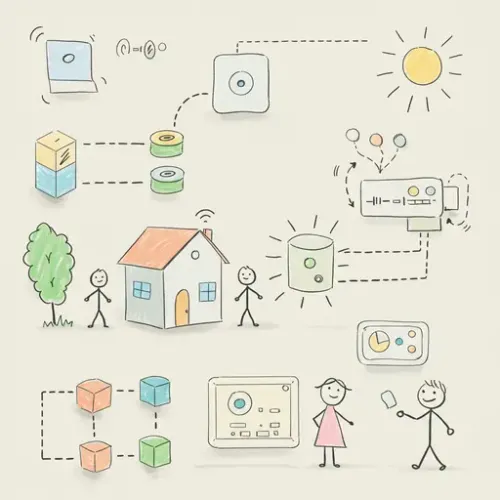Mastering Scripts and Scenes in Home Assistant for Advanced Home Automation

NGC 224
DIY Smart Home Creator
Mastering Scripts and Scenes in Home Assistant for Advanced Home Automation
Home Assistant excels at making your smart home react to events with automations. While simple automations (a trigger leading to a single action) are powerful, many real-world smart home scenarios require more sophisticated logic, reusability, and precise control over device states. This is where Home Assistant's built-in Scripts and Scenes become indispensable tools.
This guide will deep dive into understanding, creating, and effectively utilizing Scripts and Scenes to elevate your Home Assistant experience, making your smart home more intelligent, reliable, and delightful to interact with.
Understanding Home Assistant Scripts
At its core, a Home Assistant Script is a sequence of actions that can be executed on demand. Think of it as a mini-program or a macro that performs a series of steps. Unlike automations which are triggered by events, scripts are run manually or called by other automations, scenes, or even other scripts.
Why Use Scripts?
- Reusability: Define a complex action sequence once and call it from multiple automations or dashboards, avoiding duplication.
- Complex Sequences: Handle multi-step processes, introduce delays, conditions (
if/then), and choices (choose) within a single execution flow. - User-Initiated Actions: Expose common routines (like a "Goodnight" sequence) to your Lovelace dashboard for easy manual activation.
- Debugging: Isolate and test specific action flows independently of complex automation triggers.
Creating Scripts
Scripts can be created through the Home Assistant UI or by directly editing your YAML configuration files.
UI Method (Recommended for most users)
1. Navigate to Settings > Automations & Scenes.
2. Select the Scripts tab.
3. Click the "Create Script" button (or the plus icon in older versions).
4. Give your script a descriptive Name (e.g., "Goodnight Routine") and an optional Description.
5. In the Sequence section, add your desired actions. These can include calling services (e.g., light.turn_off, lock.lock), adding delays, or implementing conditional logic.
Example UI Script: Goodnight Routine
This script turns off all lights in the living room, locks the front door, waits 5 seconds, and then arms the alarm in 'away' mode.
- Choose "Call Service"
- Service: light.turn_off
- Target: area: Living Room
- Choose "Call Service"
- Service: lock.lock
- Target: entity: lock.front_door
- Choose "Delay"
- Delay: 00:00:05
- Choose "Call Service"
- Service: alarm_control_panel.alarm_arm_away
- Target: entity: alarm_control_panel.home_alarmYAML Method (For advanced users or version control)
You can define scripts directly in your configuration.yaml under the script: section, or, more commonly, include them from a separate file like scripts.yaml by adding script: !include scripts.yaml to your configuration.yaml.
Example YAML Script: Goodnight Routine
goodnight_routine:
alias: "Goodnight Routine"
sequence:
- service: light.turn_off
target:
area_id: living_room
- service: lock.lock
target:
entity_id: lock.front_door
- delay: "00:00:05"
- service: alarm_control_panel.alarm_arm_away
target:
entity_id: alarm_control_panel.home_alarmCalling Scripts
Once created, scripts can be activated in several ways:
- From Automations: As an action within an automation, use the
script.turn_onservice, targeting your script's entity ID (e.g.,script.goodnight_routine). - From Lovelace Dashboards: Use a "Button" card or an "Entities" card to trigger the script.
- From Other Scripts: Scripts can call other scripts, allowing for modular and layered logic.
- Developer Tools: In Developer Tools > Services, select
script.turn_onand choose your script.
Mastering Home Assistant Scenes
A Home Assistant Scene defines a specific state for a collection of entities. Instead of turning on lights one by one and setting their brightness and color, a scene captures a "snapshot" of how you want specific devices to be and can restore that snapshot instantly.
Why Use Scenes?
- Instant Recall: Quickly set multiple devices to a predefined "mood" or state (e.g., "Movie Night," "Work Focus," "Relaxing Ambiance").
- Simplicity: Dramatically simplifies automations or manual controls that would otherwise require multiple service calls to achieve the same effect.
- Consistency: Ensures devices always return to the exact same state for a given scenario.
Creating Scenes
Similar to scripts, scenes can be configured via the UI or YAML.
UI Method (Recommended)
1. Navigate to Settings > Automations & Scenes.
2. Select the Scenes tab.
3. Click the "Add Scene" button.
4. Give your scene a descriptive Name (e.g., "Movie Night").
5. Home Assistant will often suggest entities that are currently "active" in your home. You can manually add entities and set their desired states (e.g., light brightness, color, switch state, cover position).
Example UI Scene: Movie Night
This scene dims living room lights, changes their color, turns on a TV backlight, and closes blinds.
- Light: Living Room Lights
- State: On
- Brightness: 20%
- Color: Orange-ish (e.g., RGB: 255, 160, 0)
- Light: TV Backlight
- State: On
- Brightness: 50%
- Color: Blue (e.g., RGB: 0, 0, 255)
- Cover: Living Room Blinds
- State: Closed
- Media Player: TV
- State: OnYAML Method
You can define scenes in your configuration.yaml under the scene: section, or more commonly in a separate file like scenes.yaml by adding scene: !include scenes.yaml to your configuration.yaml.
Example YAML Scene: Movie Night
- name: "Movie Night"
entities:
light.living_room_lights:
state: on
brightness_pct: 20
rgb_color: [255, 160, 0]
light.tv_backlight:
state: on
brightness_pct: 50
rgb_color: [0, 0, 255]
cover.living_room_blinds:
state: closed
media_player.tv:
state: onActivating Scenes
Scenes are activated using the scene.turn_on service, similar to how scripts are called.
- From Automations: As an action, use
service: scene.turn_ontargeting your scene's entity ID (e.g.,scene.movie_night). - From Scripts: Include a
scene.turn_onservice call within your script's sequence. - From Lovelace Dashboards: Use a "Scene" card, "Button" card, or an "Entities" card to trigger the scene.
- Developer Tools: In Developer Tools > Services, select
scene.turn_onand choose your scene.
Integrating Scripts and Scenes for Powerful Automations
The true power emerges when you combine scripts and scenes. For example, an "Evening Routine" automation could:
- Trigger: Sunset or 8:00 PM.
- Action 1: Activate the "Evening Ambiance" scene (sets lights, music player).
- Action 2: Call a "Close All Blinds" script.
- Action 3: Call a "Notify Dinner Prep" script (sends a notification).
This modular approach keeps your automations clean and makes complex routines manageable.
Best Practices for a Robust Ecosystem
- Clear Naming Conventions: Use descriptive and consistent names for your scripts (e.g.,
script.turn_off_all_lights) and scenes (e.g.,scene.morning_mood). This improves readability and maintainability. - Modularity: Break down large, complex routines into smaller, focused scripts. This makes them easier to debug, reuse, and understand.
- Comments & Aliases: For YAML configurations, use comments (`#`) to explain complex logic. In the UI, use the "Description" field. For scripts in YAML, the
aliaskey provides a human-readable name in the UI. - Test Individually: Before integrating scripts or scenes into a complex automation, test them in isolation using the "Run" button in the UI or Developer Tools.
- Leverage Tracing: When a script or automation doesn't work as expected, use the "Trace" feature (available in the UI for automations and scripts) to step through its execution path and identify where it failed.
- Version Control: If you use YAML for your configurations, consider storing your Home Assistant configuration in a Git repository. This allows you to track changes, revert to previous versions, and collaborate more easily.
Troubleshooting Tips
- Check Logs: The Home Assistant log (Settings > System > Logs) is your first stop for identifying errors. Look for messages related to your script or scene.
- Verify Entity IDs: A common mistake is a typo in an entity ID (e.g.,
light.living_room_lightinstead oflight.living_room_lights). Double-check all IDs. - Service Call Syntax: Ensure your service calls adhere to the correct domain.service format (e.g.,
light.turn_on, not justturn_on). - Device State: For scenes, ensure the devices you are trying to control are online and responsive before activating the scene.
- UI vs. YAML Discrepancies: If you manually edit YAML, remember that the UI might not always reflect unsupported or incorrectly formatted YAML. Reloading scripts/scenes from Developer Tools or restarting Home Assistant may be necessary after manual YAML edits.
Conclusion
Scripts and Scenes are cornerstones of advanced Home Assistant automation. By mastering these powerful core features, you gain the ability to create highly customized, reusable, and reliable sequences of actions and device states. They abstract away complexity, making your automations more efficient and your smart home more intuitive to manage. Experiment with them, break down your routines into modular components, and watch your Home Assistant setup transform into an even more intelligent and responsive environment.

NGC 224
Author bio: DIY Smart Home Creator
